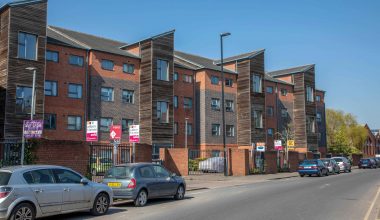In this property special If You Ask Me feature, we turn the spotlight on the change of use in the sector.
With this being a key theme during and post-COVID, unLTD chats to a host of industry experts about the evolution of our local high streets and workspaces.
Some contributors also share their views on opportunities in city centres and suburban areas, while others discuss the developments which are continuing to prove successful – and, ultimately, the trends that are driving the market right now.

Wayne Fletcher, Founder and director, Austin Fletcher
High street development styles and planning will need to adapt to the requirement of the public.
Hospitality should be key to the resurrection of the city centre. Public demand should be high as we move out of lockdown and restrictions relax over the spring and summer months. The key here is whether it can be sustained over the winter months, and if we can avoid further lockdown restrictions, to retain the confidence of the consumer and investor.
I envisage European style restaurant and café dominated zones, which provide the ambience as well as the product. Areas of green open space will add to the pro-pedestrianised vibe, offering the consumer a more relaxed, enjoyable dining experience.
Retail must evolve to provide a USP that online shopping cannot compete against. It will be interesting to see how retailers approach this and their proposed solutions. We may witness the introduction of more pop-up shops, partnerships and shared retail spaces and I suspect we will see an enhanced city centre ‘consumer experience’, with entertainment and added attractions to entice people into the city centre. Public realm and green open spaces should also play a major part in this.
High street office space will inevitably change with an increase in flexible working and shared office space, leading to the repurposing and change of use of some buildings.
The dynamics of city centre living is in a constant state of evolution due to the changing demands of communities and businesses.
City centre living may become more popular as areas are pedestrianised and green spaces start to sprawl, making city centre living a more aesthetically pleasing place to live. This is becoming increasingly more important to particular demographics, with a keen focus on sustainability and eco-friendly choices.
Historically, the majority of city centre living spaces have been occupied by young professionals and students With the introduction of green spaces and areas of natural beauty, city centres will evolve into a much softer, warmer, and welcoming place to live, encouraging young couples and families to areas they may not have previously considered.
As city centres evolve, with some areas inevitably changing to form purposeful residential zones, there will be a new demand for retail and hospitality generated from those areas. Rather than feeding city centre workers 9 to 5 and weekend shoppers from suburbia, it is possible the client base for many businesses will switch to a more local residential one.
As we start to recognise that COVID-19 is not suddenly going to disappear and it is something we need to accept and live with long-term, it is apparent significant changes need to be made to how we operate daily.
The pandemic has provided a focus on wellbeing for employers and employees which presents an opportunity to adapt to a more favourable work/life balance which will no doubt lead to some significant changes.
Office space will still be in demand for some businesses as working from home (WFH) does not work for all employees and employers. However, COVID-19 has helped to shed the WFH stigma and given employers confidence and a heightened level of trust in employees, enabling them to implement new ways of working. I expect most will adopt a flexible working environment, downsizing office spaces or introducing hot-desking.
Much existing office space will require restructuring and air quality improvements to ensure compliance for social distancing and ventilation measures. Continued WFH practices will also likely mean a demand for dedicated home office space – something property developers and agents will be keen to explore. It will be interesting to see how this impacts how houses are rented and advertised, going forward.

Josh Weston, Lead Director, Fourth Wall Building Consultancy
Sheffield has such a lot to offer. Some of the big retailers leaving the city seems like an immediate hit, but it also presents an opportunity to develop the vibrant and dynamic business offering in the city.
There’s a really strong base of innovative independent producers and operators, and in the not-too-distant future we’ll see opportunities arising as hospitality bounces back, more independent SMEs develop, and we see the re-purposing of big commercial spaces.
When it comes to high streets evolving in the future, people want more now. We’re looking for experiences. We don’t just want to go to a shop anymore, we want to shop with a prosecco in hand, pop to a quality barbers next door and then meet friends for lunch and indoor golf.
Our future workspaces are no longer just a desk in a grey room – an office needs to offer more. Although demand for offices may drop, Sheffield always needed more Grade A office space so we could see a more level field of demand versus supply. Changes in working patterns are forcing owners, landlords and businesses to look at office quality. We’ve worked with landlords in Manchester on schemes to retrofit buildings with showers, bike storage, recreational areas and even cafes. Amenity offering is now seen as essential by employers and employees. Much like retail, the office must now become a destination beyond its primary use.
Alongside retail, city living will influence how our centres look in the future. The need to build upwards not outwards is still evident as demand for homes continues to outstrip supply, but, after more than a year at home, there’s a clear desire for green space and communal areas.
Our suburban areas have always had their own centres and as house prices soared over the past year, many looked to move to areas offering greenery and space. Now life is opening up they need a reason to stay. The hospitality demand was always there, and as we’ve flocked to pub gardens again, that industry may just come back stronger than ever, so we’ll see more independent hospitality and experience-driven destinations.
As the vast industrial heartlands of the north have been forced to find rejuvenation and a new purpose over the last 40 years, so will many of our current city centre retail and office spaces post-pandemic. The key to the success of this, then as now, is dynamic organisations working collaboratively to create positive change. It will require vision and determination against natural pockets of resistance from some. Building Meadowhall in the middle of acres of disused industrial stock was toted at the time by some as doomed to fail. It became one of the most valuable and well-known shopping destinations in the country, serving as the catalyst for redevelopment of the wider Don Valley area.
Change isn’t always a bad thing. If it weren’t for deindustrialisation, I’d probably be covered head to toe in soot down a mine, instead of sat comfortably at home in my shirt with a coffee. ‘Proper work’ my Grandad would say – maybe he was right. A real tragedy, I’ll never know, I’m sure.

Dean Pattison, Director, Utility Source
The pandemic has influenced a huge change in the way businesses operate, especially small businesses who have become accustomed to staff working remotely, building up the required level of trust to continue this trend in the long term.
We have seen small businesses choosing not to renew property leases and many high street brands which have sadly fallen victim to the difficult economic circumstances. This, combined with the continued growth of online shopping, is leaving an aftermath of empty buildings in high streets across the country. Certainly, in the short term we do not see a great number of these properties re-opening as shops and there is a real potential for property investors to convert them into affordable living space.
We are seeing a trend of apartment blocks and houses in multiple occupation become a significant city centre presence. These developments are generally conversions of commercial premises and are popular due to the obvious advantage of city centre access. Suburban areas are slightly different, pubs and commercial premises are still subject to conversion, but there is more of a trend of small housing estates being constructed. These typically involve ten new plots or fewer and are often constructed by the smaller developer.
Recently, we have seen a surge of enquiries and orders to support developers through commercial to domestic developments – specifically, the conversion of pubs and office blocks into affordable flats or houses in multiple occupation prepared for rental. The immediate attraction for a developer is they have a ready-made shell with little or no structural works to be completed which influences an accelerated development programme.
We deliver a service to property investors and developers who are purchasing buildings pre-conversion. We’d recommend they always incorporate the review of utility infrastructure within their due diligence before purchase. Rarely is a commercial building already equipped with utilities sufficiently configured to enable a conversion into a building of multiple occupancy. For any operational amendments, town centre working can be restrictive and costly and without the required due diligence a developer can incur time restrictions and costs they have not budgeted for.

Ben Ellis, business development manager, Prodek Design and Storage Systems
The Sheffield business community is already driving the city towards an exciting future. There are some impressive manufacturing and technology companies, which perfectly complement our innovative small enterprises.
Developing a healthy blend of work, culture and leisure in the city needs the support of local government. Businesses will never stop innovating – they just need help to get going and have access to a pool of well-trained local talent. We have seen a surge in business owners wanting to make the most of existing premises. This makes good financial sense because they are avoiding the expense and disruption of moving premises. For Prodek, this trend centres on office fitouts and refurbishments to accommodate growing staff numbers, and more recently, to safely welcome them as they return to the office. Our designers have been very busy redesigning premises to maximise every square metre. We implement clever storage systems to make room for new COVID-safe desking and meeting areas and use glass partitions to create private offices and break-out areas.
The dramatic increase in online shopping has prompted many of our bricks and mortar retailers to embrace ecommerce as an additional sales channel, with online retailers seeing a boom in sales. Distribution and fulfilment centres are investing in existing warehouse operations and fitting out new centres with the best kit available. Speed and accuracy are where the advantage lies in distribution so investing in warehouse racking makes all the difference to pick rates.
The government road map has given everyone a small confidence boost, in our experience – we have seen a rise in enquiries from businesses wanting to increase floor space in existing premises and the solution is a mezzanine floor. We have restaurants, schools, manufacturers, and shops weighing up the cost of a mezzanine compared with moving to larger premises – mezzanines usually win. Most businesses want to remain in their existing location because they have spent years building a local customer base or because their staff love being able to walk or cycle to work.
Most premises can be completely transformed – it just takes an experienced eye to see the potential. The city is brimming with properties which can easily be adapted to suit almost any business – making good use of existing city assets and leaving green spaces in and around the city to flourish.








